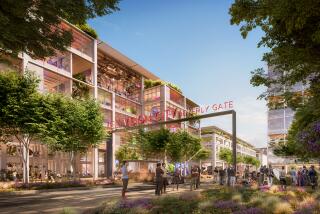Golf Debate Draws Gallery of Foes and Backers
- Share via
Opponents of a proposed 18-hole golf course in Big Tujunga Canyon, including environmentalists and Native Americans, warned a City Council panel Tuesday that the development would ruin sensitive plant habitat and lead to an “ecological disaster.”
About 30 people urged the council’s Planning and Land Use Committee to reject the 350-acre project proposed by Foothills Golf Development Group.
But the opponents were outnumbered by nearly 70 supporters who argued that the project will beautify what they called a rubbish-strewn wash, provide a much-needed recreation facility and create commerce in the northeast San Fernando Valley.
“The golf course can only do one thing: improve the area,” said Kathy Anthony, president of the Sunland-Tujunga Chamber of Commerce.
Despite emotional testimony on both sides, the panel delayed a decision to give Councilman Joel Wachs more time to decide on the project. Indeed, Wachs will play a key role in the project’s fate because he represents the area and the council is expected to defer to his judgment.
Wachs listened intently as both sides spoke for nearly three hours.
“The quality of the testimony from both sides has been superb,” he said.
But Wachs hinted that he would support the project unless the city can find the money needed to buy the land and retain it as open space.
“‘This is the most environmentally compatible use I have seen for this land,” he said.
The area is owned by Cosmo World Corp., a company incorporated by Japanese golf magnate Minoru Isutani, who has tried to build the project since 1987.
Cosmo World first tried to turn the rocky landscape into a championship golf course, with cement linings in the waterways to control flooding.
After opposition by the U.S. Fish and Wildlife Service, Cosmo World leased the land to Foothills Golf Development, which proposed a revised project.
The new plan calls for a $12-million public golf course covering about 350 acres, including 190 acres of undeveloped open space, including horse trails and a preserve for the endangered slender-horned spineflower, which thrives along the wash.
Opponents of the project include Vera Rocha, chief of the Shoshone-Gabrielino Nation, which claims the wash as part of its native ancestral land.
“This land and every part of the area is part of our village,” she said. “Let us leave something for our children and grandchildren.”
A spokesman for state Sen. Tom Hayden (D-Los Angeles) predicted the project would cause an “ecological disaster” in the wash and urged the panel to work with the state government to buy the land.
The project is opposed by the California Department of Fish and Game, the Sierra Club, the San Fernando Valley Audubon Society and the Santa Monica Mountains Conservancy, among others.
But supporters, who include many adjacent neighbors and business leaders, said the wash is strewn with trash and attracts vagrants and graffiti vandals.
They argue that the golf course and the spineflower preserve would enhance the area.
“It is nothing but shopping carts, trash, homeless people, and it’s dangerous to traverse,” said Royan Herman, an eight-year resident of nearby Shadow Hills.
Wachs promised to make a final decision by June 10, the date the panel will meet again on the project.
More to Read
Sign up for Essential California
The most important California stories and recommendations in your inbox every morning.
You may occasionally receive promotional content from the Los Angeles Times.











